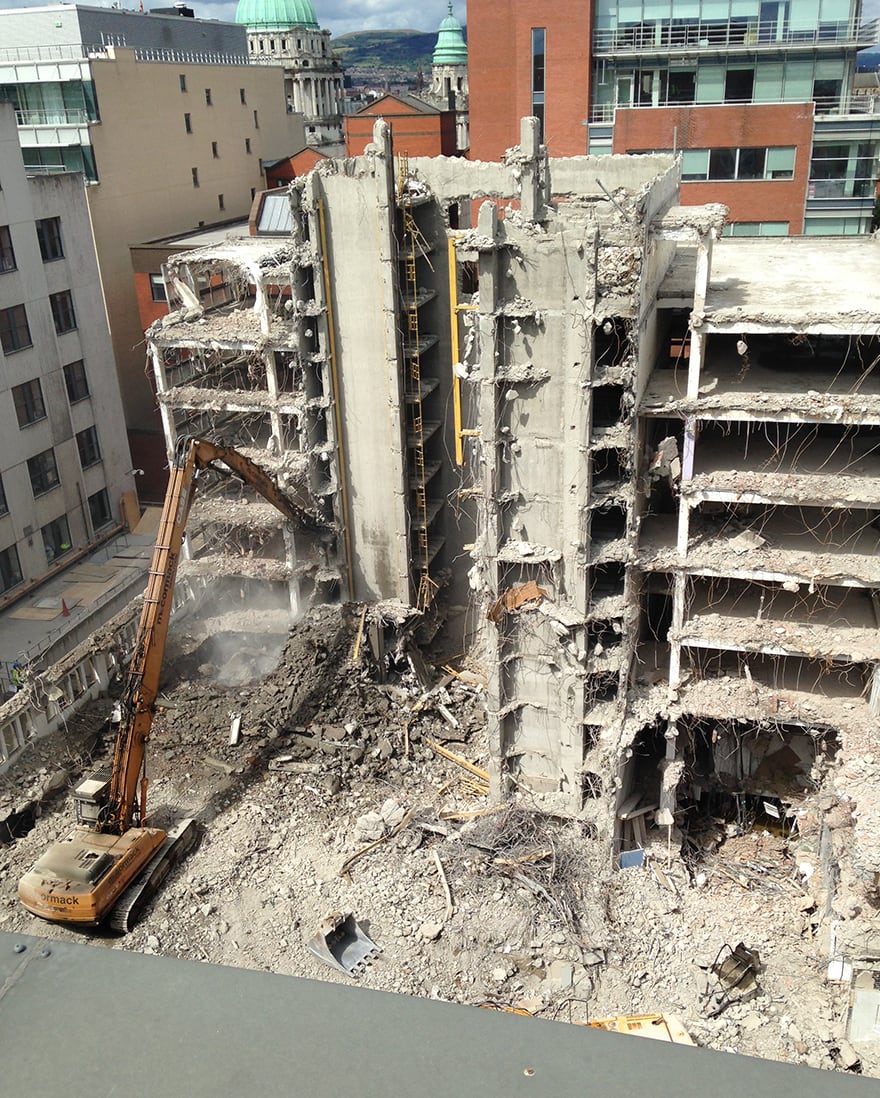- Client: Belfast City Council
- Lead Contractor: McAleer & Rushe
- BIM Tools: Aconex, Revit, Navisworks Manage
Margaret Conway made history this year by being crowned the first female Construction Manager of the Year in October. The McAleer & Rushe project manager took the top prize for her work on a £22m nine-storey office block in Belfast City Centre. The 9,300 sq m office block was completed in 80 weeks. The project was also the first time the company had implemented BIM Level 2.
How was BIM implemented on the project? What software was used?
The Architectural, Structural and M&E Design Teams developed separate models to support the coordination of the design, from concept through to completion.
Aconex was used as the Common Data Environment (CDE) to manage all project information. Aconex also provided us with the opportunity to “link” information to the model and track progress against the Master Information Delivery Plan (MIDP).
Revit was used by the M&E and structural consultants and Archicad was used by the architects as the primary model authoring tool.
Navisworks Manage was used for carrying out clash tests and Navisworks Freedom and the Aconex Model viewer were used by the rest of the project team for viewing the model only.
With support from Leica, we also trialled the use of point cloud technology on Adelaide Street.
How was BIM used to collaborate with rest of team?
Relevant project participants were given access to up-to-date models, to enhance their understanding of the design. All meetings were model based.
What were the main benefits?
The BIM workflow worked well within Aconex, facilitating more in-depth discussion, particularly regarding technical detailing.

The 9,300 sq m office block was completed in 80 weeks
What were the difficult bits of using BIM on the project?
The greatest difficulty was establishing a suitable approach for McAleer & Rushe and sourcing the appropriate software solutions that would support the way our design and construction teams worked.
Also our consultants were using different software so it was necessary to convert everything back to IFC format before each data drop.
As this was a D&B project BIM also created challenges with our procurement programme. Model-based drawings can have a huge impact on the timeline for the production of drawings.
With traditional 2D drawings, procurement packages are produced sequentially, but with BIM you have to wait until the whole model is complete and then you get most of your procurement packages at the one time.
Was the use of BIM something important to the client, was data exchanged at the end?
The BIM Level 2 mandate came into play in April 2016 for all central government projects over £4.3m. In compliance with this, Belfast City Council required an Asset Information Model (AIM), with a suitable level of detail to support their ongoing management of the facility. This was delivered in a final data drop to the client.

The work was carried out under a D&B contract
Prior to appointment we reviewed their Employer’s Information Requirements (EIRs) to determine if they met the client requirements as sometimes they can be very onerous and through discussions with the client it might become evident that such a high level of detail and information is not required.
After this process we produced our BIM Execution Plan, which became a contract document.
What impact will BIM have on McAleer & Rushe?
A BIM workflow will facilitate better information management, better decision making and improved efficiency overall. We are continuing to develop our BIM expertise and capabilities.
Is there anything you might have done differently on the project with hindsight?
Our biggest challenge was producing a sufficiently detailed model to allow us to procure our main packages, particularly MEP, without incurring abortive design works when the subcontractors come on board and want to make changes to specifications and/or layouts.
This is particularly challenging on D&B projects or when procurement is based on performance-based specifications.

With traditional 2D drawings, procurement packages are produced sequentially, but with BIM you have to wait until the whole model is complete and then you get most of your procurement packages at the one time.– Margaret Conway, McAleer & Rushe
Comments
Comments are closed.













A good outcome to the team. Well Done.
I bet it was a pain to have the architects not using Revit and forcing everyone to continually export to IFC and coordinate their work in a non-native software i.e. Navisworks. These exports BTW don’t just happen at data drops that happen continually fortnightly throughout the design. Its disappointing that a design team is selected without key players speaking the same BIM software language. This should be written as a prerequisite by the client.
Once again, it sounds like the EIR was written for the Client by an Architect who didn’t bother to actually ask the Client if they can use BIM to begin with. In doing so it sounds like the EIR asks for full COBie when the client at project end had absolutely no capability to use it. Poor performance at these initial stages in writing the EIR causes stress and extra work for the project team during later design, documentation and construction stages. Stop over specifying, talk to your client and lets make BIM work pragmatically.